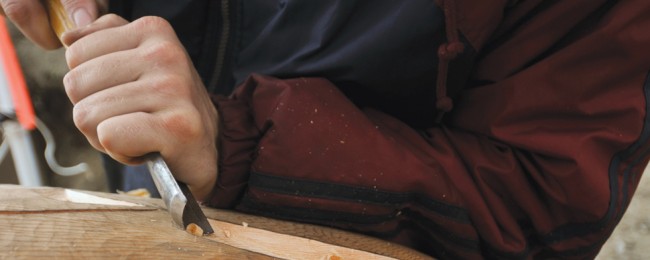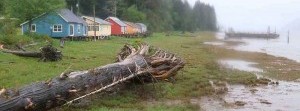
Photo Credit: Dave Quinn
Gwaii Haanas Legacy Pole—First monumental pole in 130 years celebrates Haida past and future
I first visited Haida Gwaii nearly 20 years ago with three friends, before the temporary moniker Queen Charlotte Islands was returned to BC, respectfully gift-wrapped in a cedar box, in 2010.
Road tripping across BC on a late-September, early-20s adventure, four borrowed kayaks strapped to the roof of my truck, we held on for dear life as the ferry from Rupert bucked like a colt through a Hecate Strait gale.
Queen Charlotte City seemed like the proverbial port in the storm in every sense of the word. The moist air was rich with verdant rainforest growth spiced with wind-born sea salt. Everyone we met seemed genuinely stoked to meet us. And kindness seemed to be the local modus operandi. The ferry captain even let us pilot the small ferry that runs from Graham to Moresby Island. Where does that happen?
Two decades later, on Aug. 15, I was honoured to join over 400 people, including BC conservation officers, federal fisheries officers, RCMP, Parks Canada staff and hundreds of Haida of all ages, many draped in button blanket and cedar hat regalia, who braved rough seas to be part of the first monumental pole raising in Gwaii Haanas in 130 years.
Since 1993, I have been back to the islands at the edge of the world almost annually, guiding late spring sea kayak expeditions in an annual rendezvous with the migrating whales, breeding seabirds and eagles, and giant trees of Haida Gwaii. Much has changed since my first visit, but its beauty remains the same. Humpbacks in the hundreds pause here in their annual pilgrimage from Hawaii to the Alaskan fjords. The highest density of nesting bald eagles on the planet fills the air with squeaky clothesline calls, and nearly a million pelagic seabirds come ashore to nest.
The damage done
But the fragile island ecosystem, undisturbed for tens of thousands of years, is under assault. Raccoons—introduced as a potential source of income when Davy Crockett hats were the rage—and rats, those universal parasites, smuggled themselves ashore from logging barges and visiting ships; they’ve taken a heavy toll on seabirds, wiping out entire colonies tens of thousands strong in just a few seasons.
Another introduced character, the Sitka blacktail deer, has multiplied relentlessly in this predator-free archipelago, to the point that native flowers and shrubs, once a thick carpet across the archipelago, are now only found on remote, rocky headlands. Locals fear for the culturally critical western red cedar, whose seedlings are gobbled up by the deer. A cull on two remote islands is attempting to restore balance, but even on Reef Island, 10 km offshore, hunters killed 75 deer over five years. They even enlisted the unlikely dachshund to help with the roundup. Weiner dogs hunting deer in the rainforest. Such is the mystery of Haida Gwaii.
The deep, timeless momentum of this rich archipelago continues in spite these threats, and Haida Gwaii is still known in many circles as the Galapagos of the North.
But despite the biological richness, it is Haida Gwaii’s human treasure that continues to lure me back. Islanders in general are known to be a friendly lot, but it seems like the Haida, who have called Haida Gwaii home for close to 10,000 years, take hospitality to a new level. While isolated animosities to off-islander non-aboriginals do exist (not surprising after over a century of the Indian Act and its residential schools and potlatch bans), my sensory memory is alive with tastes of fresh, Haida-caught abalone, salmon smoked six different ways, fresh venison with wild cranberry sauce, sguu, dried seaweed and k’aaw, herring roe-on-kelp, fresh and smoked.
My mind’s eye squints into beach fires under the visage of greying totems, laughter and new language shared, a west coast sunset settling into the sea at our backs. One of the first words you learn in Haida, and the one you use the most, is Haw’aa: Thank you. Proud, strong, independent and welcoming are some of the essences of the Haida Nation.
The rising up of a nation
But in 1985 the welcome mat was rolled up, as members of the Haida Nation tired of watching island after island stripped of their old-growth blankets from sea to skyline. Some of these alder-choked hillsides and the open sores of landslides continue to ooze today, nearly 40 years later.
The 1985 logging blockade on Lyell Island resulted in over 70 Haida arrests and international attention. The Haida declared the southern third of Moresby Island, called Gwaii Haanas, a Haida Heritage Site. Richard Wilson, known as Captain Gold, founded the Haida Watchmen program that same year. After nearly a century of abandonment, the ancient village sites once again had seasonal Haida caretakers to safeguard these cultural treasures and deepen the connection between the modern Haida Nation and its past.
Years of intense negotiations, political scandal (BC Premier Bill Bennett and most of his 1985 cabinet were shareholders in Western Forest Products, who held the timber licence for the area) and international pressure ensued. Finally, the historic 1993 Gwaii Haanas agreement protected the area under the shared oversight of the Government of Canada and the Haida Nation. Despite a major difference of opinion regarding ownership, Gwaii Haanas National Park Reserve and Haida Heritage Site was born. With the addition of National Marine Conservation Area guidelines in 2010, it became the world’s only mountaintop-to-seafloor protected area.
To acknowledge the 20-year anniversary of the groundbreaking Gwaii Haanas document, Parks Canada commissioned Masset carver Jaalen Edenshaw to create the Gwaii Haanas Legacy Pole.
What goes up
On that sun-streaked August day, 30 youth from Masset and Skidegate, paddling traditional Haida canoes, made their first-ever visit to the park. Their paddle song, ceremonial request to come ashore, and welcome by the local hereditary chief was an emotionally charged highlight. Accompanied by a frightening visit by the mischievous spirit Gogit, a blessing of eagle down and water, and drumming and singing, the pole literally leapt upright, as hundreds of hands heaved together on six thick ropes.
Alongside the pole’s traditional grizzly bear, raven, eagle and sculpin, five figures with linked arms represent those who took a stand in the 1985 blockades, and Sacred-One-Standing-and-Moving is a mythical figure who holds up the archipelago, shaking it when he moves. His last dance resulted in last October’s 7.7 magnitude quake that temporarily blocked Gwaii Haanas’s famous hot springs, which are now slowly returning.
In two decades—but a hemlock needle on the sea of Haida Gwaii’s tremor-rattled history—I have seen the tentative return of the humpbacks, testing rich waters where a handful of whaling stations once decimated their numbers. But every shed-sized stump, every man-width, saw-cut, wasted log on the beach, every landslide and alder-carpeted hillside still breaks my heart. I will not live to see a true Pacific rainforest here again. Nor will my children, or theirs.
It has been with mixed feelings of understanding, twinged with my own culture’s obsession with accumulation and preservation, that I have watched rotting-red chunk after chunk fall from the last of the ancient, standing poles at the Gwaii Haanas villages of S’Gan Gwaay and Skedans. They were always designed with the impermanence of nature in mind, and their destiny, despite their compelling beauty as monumental art, is to return to the earth.
Edenshaw’s Legacy Pole will look out past the rocks of Windy Bay for a century of North Pacific sunrises, to a future for Gwaii Haanas that promises to be as exciting as its past.







